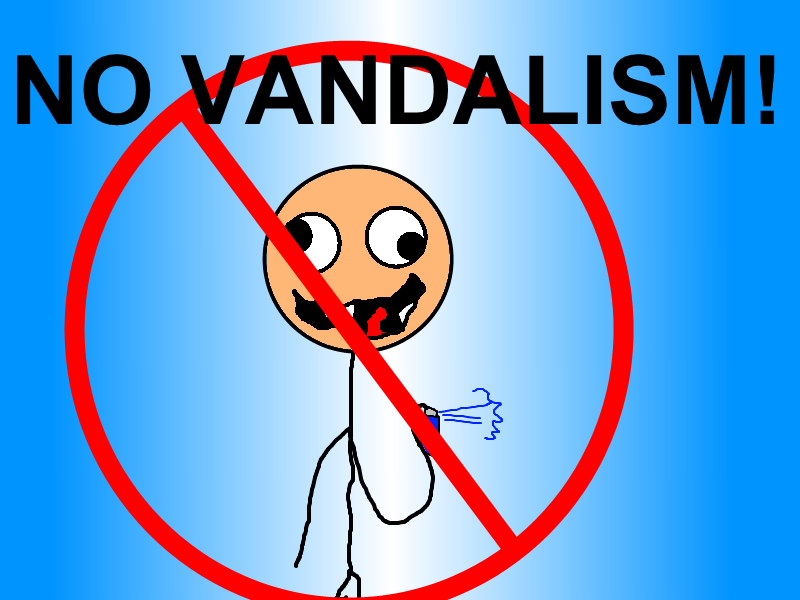Adults are disgusted when they encounter vandalism in public places… It is often viewed as a form of moral degradation; acts of willful destruction “for the hell of it;” “young people gone wild” trying to project a sense of power…. And then there is graffiti and tagging as “an art form” in certain contexts. However, when you examine the incidence and types of vandalism, a different picture may emerge. Some researchers believe that all types of vandalism can be classified as revenge or “reactive aggression.” Others disagree…
The incidence of vandalism in the United States is in the millions. (It is curious that there is little current data). According to the Center for Problem-Oriented Policing http://www.popcenter.org hard data is available for school vandalism.
School Vandalism – A $600 Million Problem in 1990
The public perception of school vandalism is no more than “a nuisance.” According to the Center for Problem-Oriented Policing, School break-ins come in three varieties:
- Nuisance Break-ins – committed by youth for no rational purpose other than to be destructive with no theft involved;
- Professional Break-ins are those committed by criminals with a high level of skill. They typically target storage areas with expensive equipment for a good monetary return on stolen goods. They may do incidental damage “for show;”
- Malicious Break-ins – are characterized by extensive damage to the interior… and may include arson. Stealing appears to be secondary.
Over the past 20 years, vandalism in and of itself has “taken a back seat” to other school issues such as gangs, drugs and the use of weapons. However, vandalism takes a back seat, as does intimate partner homicide… as they both appear to be vastly underreported. In the mid 90’s (most current data) over one third of U.S public schools, (84,000) reported at least one incident. Incidents counted totaled a meager 99,000. Why such lack of reporting?
- Differing definitions including intentional and accidental damage;
- Reporting only those incidents that result in an insurance claim or conversely, reporting only those incidents which are not covered;
- School administrators fail to report because they feel it is a poor reflection on their management skills or they view such incidents as “trivial.” As a result, few perpetrators are caught… and even less is convicted.
Common sense is backed up by research in that positive role models and success in school are factors “reducing the likelihood” of vandalism. However, not all vandals necessarily are adolescents. U.S. data collected in 1995 indicated that 32% of those arrested were over 25 years old. The same study pointed to the fact that the proportion of arrests for arson also numbered 32% as stated by Skorokhodova Anastasia – Researcher, Sociological Institute of the RAS. The thrust of social research has been to identify the motive for vandalism. Stanley Cohen, The Future of Vandalism delineates six types of vandalism.
- Vandalism as a means of purchase is also described as a kind of theft. Such things as decorative accessories, equipment, metals and cemetery artifacts qualify here;
- Tactical vandalism is characterized by “avoiding the inevitable” such as a business failure… to destroy inventory etc.
- Ideological vandalism includes vandalism in order to pursue social or political goals. For example, between 1789 to 1800, 169 monuments were anniatated over the years as a form of protest against monarchs, Catholicism and other movements;
- Vandalism is also seen as a form of revenge in response to injury or insult. It is typically a delayed response to another “offender” by an anonymous person. The object of the destruction can only be indirectly or symbolically linked to the primary source of the hostility. This type of revenge supposedly fills an emotional need, but also avoids personal confrontation – “safe, reliable and always sweet;”
- Vandalism can be considered a “game,” most often practiced by children and adolescents. Within this kind of game, the destruction raises the status of a vandal to his/her peers. They are seen as strong and courageous. Vandalism seems to instill competition (which is part of the game).
- Malicious vandalism is motivated by envy, hostility, hatred of others and the “pleasure of injury.” Malicious acts may include slicing items, throwing acid etc.
- No matter which form of vandalism you espouse, perhaps a few examples can illuminate this type of crime when other types of crime frequently grab the spotlight.
November 2009- Brooksville, (Tampa Area) Florida:
Ms. Francis Greifenberger, a former NYC police officer and county jail employee caught three 13 year olds in the act of trashing a vacated home in her neighborhood, including destruction of windows, chandeliers, porcelain sinks, tile, and holes in drywall using a hammer, screwdriver and metal bat. Greifenberger cornered them in a Master bedroom ordered the boys on the floor spread eagle style and told them she had a gun. (Which was the truth!) The teens were terrified and put in home detention despite causing $40,000 worth of damage. The vandalized house was in the process of being sold in a short sale to a military officer who was to be deployed to Iraq. In the end, the neighborhood “chipped in” for the cleanup after the burglary. [LJ- If I had to guess, it appears that this vandalism was motivated by “a game” to show off to peers.]
March 2010 –East Bridgewater- Boston, Massachusetts
Four teens vandalized a Boston area home while the Steidle family was in France. The son stayed home in Boston with relatives. He went home to feed the cat whereupon “four friends” from school showed up at the house and “started a party.” The so-called friends refused to leave. The son failed to call the police immediately out of fear. The rampage included urinating on beds and floors, punching holes in walls, stealing jewelry and computers. The offenders pleaded not guilty to larceny and vandalism. The outcome – punishment for the $45,000 damage was not available to this writer. The Steidle family commented that the vicious teens “destroyed our lives.”
‘Motivation? It appears that financial gain and maliciousness toward this family (i.e. envy, hostility, hatred…as they refused to leave) or… vandalism as “a game” of one-upmanship may be at work here. Regardless… these are senseless and traumatic acts.
May 2011- Greenwich Village and Soho, New York
An apparent unprovoked attack at a Greenwich Village Dunkin Doughnuts lasted 7 minutes by a group of teens, which was part of a local crime spree. See video below….
This assault was caught on video and included terrorizing staff, hurling furniture and destruction of a $2,000 hot chocolate machine…and snatching snacks on the way out. However, no money was taken… Therefore this chaos was not about filling their pockets. The police responded- 45 minutes later. Residents described law enforcement’s reaction as “tepid.”
As this was “one of many” neighborhood crimes of similar nature, it might be classified as malicious vandalism (i.e. envy, hostility, hatred of others…) or “a game” once again. Blog posts included negative ethnic responses, as the offenders were Black and contrastingly, those who were supportive of the act and spoke of oppression.
Penalties
A “snapshot” of legal penalties can be seen as an example, by the Connecticut General Assembly’s most current legislative bill in year 2000. “An Act Concerning Vandalism of Railroad Property.” [LJ- Assumption – Someone was defacing our railways and/or endangering the safety of passengers. A concerned citizen probably called their local legislator, who was actually quite thorough in the bill’s coverage.]
However, in general, under the CGA, vandalism is classified as a less serious crime-a Class A misdemeanor with a maximum possible jail sentence. See this link for important distinctions between Class A, Class B, Class C and “unclassified” misdemeanors which may be similar in other states.
Link: http://www.ehow.com/print/info_8570242_misdemeanor-classifications-connecticut.html
“To build may have to be the slow and laborious task of years….
To destroy can be the thoughtless act of a single day.“ Sir Winton Churchill
 Donna Gore is a champion of victims rights and justice. She is a survivor of homicide and has turned her personal situations into a positive approach to life by participating in several areas of victim services. “LadyJustice” is the host of Shattered Lives, Saturdays at 5pm ET.
Donna Gore is a champion of victims rights and justice. She is a survivor of homicide and has turned her personal situations into a positive approach to life by participating in several areas of victim services. “LadyJustice” is the host of Shattered Lives, Saturdays at 5pm ET.











Good Morning Kay: Thanks for reading… I think homeowners may cover something, but don’t know the extent. I’ll have to research that… These kids that do it “as a game” are very troubling?”
DRG
Does most insurance cover damage caused by vandalism? For instance, in the March 2010 –East Bridgewater- Boston case, the family said the teens had destroyed their lives. Just wondering if the family had any financial protection via insurance. Such a waste to destroy for the sake of destroying.